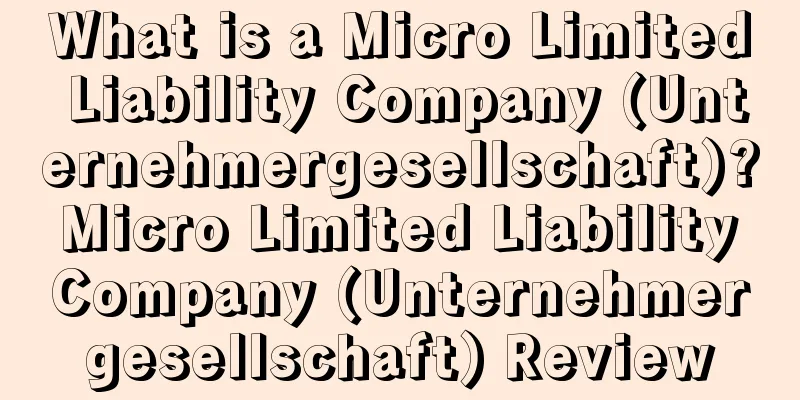What is a Micro Limited Liability Company (Unternehmergesellschaft)? Micro Limited Liability Company (Unternehmergesellschaft) Review

A micro limited liability company (German: Unternehmergesellschaft (Haftungsbeschränkt)) is a form of private limited liability company in Germany, usually established as an alternative to a German company or GmbH (limited liability) entity. Companies organized as startups have the suffix "UG (Haftungsbeschränkt)" appended to their names. Enacted on October 23, 2008 Also known as mini-GmbHbackgroundThe main purpose of the German government to introduce micro-limited liability companies is to replace the British non-listed company model (traditional companies) that was previously popular in Germany. A micro-limited liability company established under German law is not a new legal entity; on the contrary, it is a limited liability company similar to a limited liability company (GmbH). The difference between it and the GmbH is that a micro-limited liability company does not need to meet the 25,000 euro registered capital required by the law for a GmbH, but only 1 euro. Under certain conditions, a micro LLC may be certified as a non-profit entity. The micro-LLC form has generated a great deal of interest, especially among start-ups and other entrepreneurs. As of January 1, 2012, there were 64,371 such companies, including those that had converted from micro-LLCs to GmbHs and partnerships. Since then, micro-LLCs have largely replaced traditional corporate forms. Company EstablishmentThe formation of a Micro GmbH is very similar to that of a GmbH. Company Name The company name must end with "Unternehmergesellschaft (Haftungsbeschränkt)" or the abbreviation "UG (haftungsbeschränkt)" (§ 5a GmbHG) to indicate that the company has limited liability; otherwise, the company has unlimited liability. Share capital The nominal amount of the company's shares as defined in the articles of association - the so-called "ordinary capital" - must be provided after the company is founded and before it is registered in the commercial register (§ 5a Abs. 2 GmbHG). The total share capital must be at least 1 euro. In practice, in order to prevent the company from facing the risk of bankruptcy at the beginning of its establishment, it is usually chosen that the minimum amount should not be less than 1,000 euros. If the total share capital exceeds EUR 25,000, a GmbH is usually established instead of a micro GmbH (§ 5a para.1 p.1 GmbHG). In contrast to the GmbH, contributions in kind (fixed assets) are not permitted. The share capital must be paid in full in cash (§ 5a (2) GmbHG). If there is a capital of EUR 12,500, a micro (limited liability company) with a share capital of EUR 12,500 can be established, or a GmbH in the original sense with a share capital of at least EUR 12,500 (i.e. half of EUR 25,000) paid up. In the event of company insolvency, the difference between the two is that a GmbH needs to make up the minimum registered share capital of EUR 25,000, while a micro GmbH does not. advantage- Very flexible and can be used in many business models - Shareholders can also serve as directors - Very low starting capital, minimum capital of 1 Euro - Limited liability - After the share capital reaches 25,000 euros, it can be converted into a general limited liability company GmbH - Can expand overseas offices - UGs are taxed in the same way as a stock corporation (AG) or a limited liability company (GmbH) shortcoming- There is a savings obligation (25% of the annual profit must be set aside as a capital reserve and cannot be used for other purposes until the reserve reaches 25,000 euros), and profit distribution is restricted - Start-up capital cannot be replaced by fixed assets and can only be paid in cash - Complicated procedures such as registration, name change, double-entry bookkeeping, etc. - Low equity and low credit - Low initial capital, high risk of bankruptcy |
<<: What is Amazon Hijacking? Amazon Hijacking Review
>>: What is Yanwen Logistics? Yanwen Logistics Review
Recommend
What is Keepa plugin? Keepa plugin review
Amazon Price Tracker is an Amazon historical price...
What is SCI Ecommerce? SCI Ecommerce Review
SCI Ecommerce is the fastest growing e-commerce se...
What is Che Dawei? Che Dawei Review
Che Dawei, founder/CEO of Fujian Zhengyu Cross-bor...
Amazon's new policy targets FBA again! Be careful of your shipping rights being frozen!
How can FBA be delayed by machine translation? We...
Etsy's second quarter revenue exceeds $500 million! The number of active buyers has exceeded 90 million
It is learned that Etsy recently released its seco...
There is another bug in Amazon's backend, and the advertising fees are shocking!
This morning, many sellers reported in the seller ...
What is Borzo? Borzo Review
Borzo is an online express delivery platform that ...
What is Shenzhen Zehui Technology Co., Ltd.? Shenzhen Zehui Technology Co., Ltd. Review
Shenzhen Zehui Technology Co., Ltd. (Zehui for sho...
Practical skills for promoting new products on Amazon
With the rise of cross-border e-commerce, Amazon,...
Amazon launches the annual "Amazon Impulsa" event to help small and medium-sized sellers in Mexico!
Amazon has invited small and medium-sized enterpri...
Temu downloads increase: first kill Shein and then attack Amazon and eBay!
It is learned that Temu, a Chinese retailer under...
What is Tribe Group? Tribe Group Review
Tribe Group is a self-service platform between bra...
What is Anno Intellectual Property? Anno Intellectual Property Review
Guangzhou Annuo Intellectual Property Agency Co., ...
The store sold 5,000 orders a day in 3 months. The newbie in cross-border e-commerce made a comeback and sold well. Let’s listen to his business experience...
Recently, cross-border e-commerce has been pushed ...









